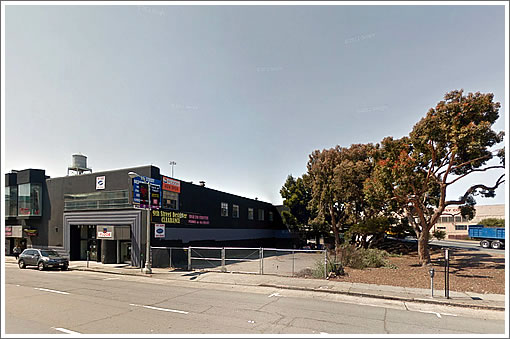
With the minimalist Muji having moved in next door and a Trader Joe’s, Bed Bath & Beyond, and Nordstrom Rack across the street (at least for now), the vacant lot at 520 9th Street which is currently used for parking was sold in January for $795,000.
According to a plugged-in tipster, the buyer’s preliminary plans for the off-ramp adjacent lot include a four-story residential building with twelve (12) two-bedroom condos over nine parking spaces and ground floor bike storage but no ground floor retail.
And while the building’s proposed design has yet to be finalized, the Planning Department “expect[s] that the architecture and quality of execution will be superior.” No word on what color the Department is expecting the building to be as well.
Really?
Location is really awkward and dangerous. (Try getting to Muji safely on foot).
Unfortunate that some of the adjacent one story structures couldn’t be razed for something larger that would work far better smack next to the ramp.
If they mean “superior” to its immediate neighbors, it’s be hard not to be. Maybe residential/foot traffic there will convince the TJ to open itself to the sidewalk.
Seems inappropriate to build residential so close to an on ramp. Commercial would be better. How will they handle Muji’s lot line windows?
I think this might need some superior soundproofing.
I don’t understand why Muji moved to that spot. I can’t imagine they’re going to do a booming trade on that side of the street; all the action is trapped inside that horribly horrible shopping center across the street.
That lot is oft used as a homeless encampment. It seems the SF Sheriff and Cal HP are in there at least once a week clearing it out. Yes, a condo bldg is a far superior use.
Not to mention the pollution. I lived in a second floor apartment on 18th and Danvers and the soot that came in my open windows was disgusting. I can only imagine what it’s like by an offramp.
Then again, housing is always in demand in SF so people will live wherever they can.
what is Muji?
Yeah, the soot from the freeways is really bad down there. I lived at 8th between Howard & Folsom and the exhaust soot covered everything.
At what point are you out of worst of the soot zone? Rillion’s 8th between Howard and Folsom is a good 2 long SOMA blocks from the freeway. Going south, how’s 14th, 15th 16th, say along Mission or any of its N-S parallels?
Or do you suppose it’s not the freeways but the heavy surface street traffic in SOMA that’s the culprit?
Of course it’s the traffic. City streets generate soot, dust and crap. I live out in parkside/sunset and we still get dirt on our quiet side street. I guess my point is whether the location’s particulate matter is any worse.
Anyway, I’d like to see a prelim design at some point. I doubt there will be many windows facing the off-ramp, but I’ve been wrong before.
Yes, soot comes from traffic, and if you are near the freeway you are getting some, but if you are far from the freeway, such as the sunset, it’s not soot, it’s dust from the sand on the beaches. The wind blows west 95% or more of the time, so there’s no soot coming from freeways to the western portions of SF. But almost every part of SF gets more or less dust from the beaches, which looks very much like soot, but has different properties.
Where is Gil when you need him? He surely wouldn’t approve of building residential housing on this land… LOL.
I live a couple of blocks away from the 280 and San Jose Ave in Glen Park. The noise while noticeable is muted but the soot in particular is far from insignificant. It’s a very convenient location but I do worry about the long term impact of exposure to the air. The idea of living next to a freeway off ramp seems crazy. That’s why ORH and the Arterra make no sense to me…
At least at ORH the residents of the highest floors are not as exposed to the particulates from the freeway. The further you are from the freeway surface (horizontally or vertically), the cleaner the air.
I tried nosing around to find a fine grained map of SF air quality and all I could find was this which isn’t detailed enough to show how particulate intensity peaks adjacent to heavily traveled roads.